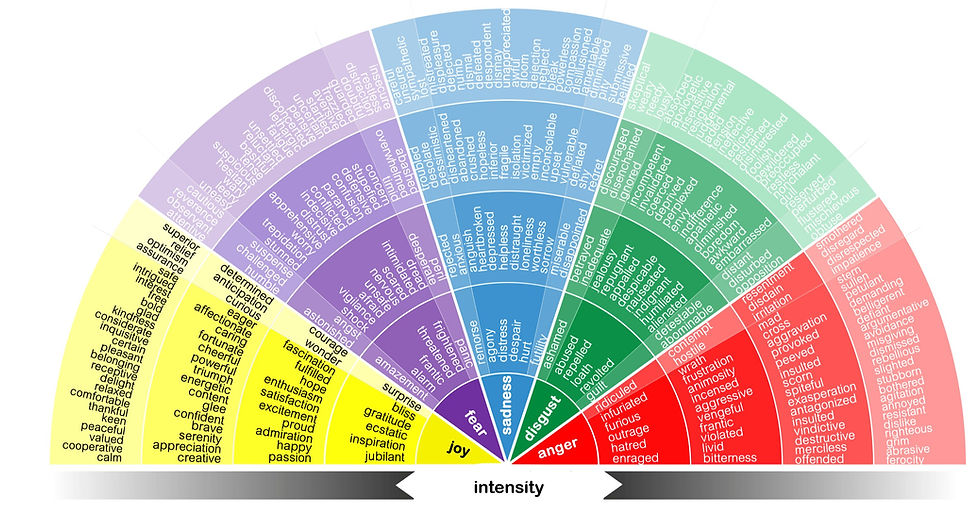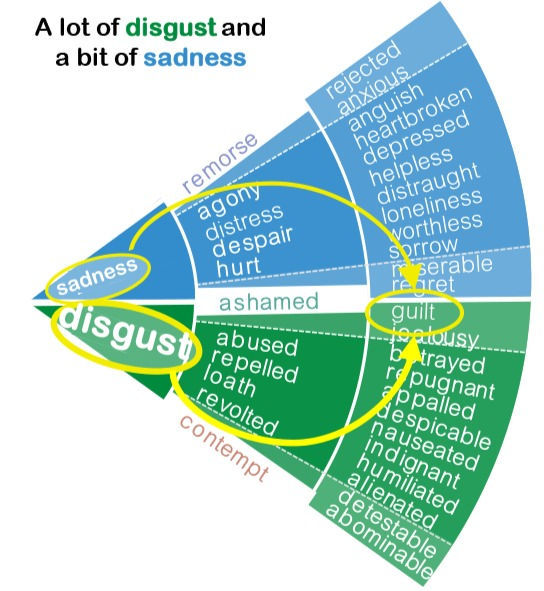- Lance Drozda, RPC-C
Our 5 Basic Emotions and How They Get Complex

Our biggest challenge is not figuring out how we feel - it is figuring out how to describe our feelings to others in a way that they will understand. This is one of the first things we teach in our workshops because labeling emotions can become complex, and it can become complex quickly.
Our emotional experiences are rooted in five core emotions: joy, fear, anger, disgust and sadness. However, our ability to combine and mix emotions and then feel them in a variety of intensities increases our emotional experience exponentially. And it is here where we experience the complexities in communicating to others how we feel.
Consensus on Our 5 Basic Emotions
The concept of core or “primary” emotions is not a new one. It is based on the premise that we, as humans, are “hardwired” with a defined set of basic emotions that have evolved in response to basic survival needs. In the early 1980’s, the work of Robert Plutchik defined eight core emotions, which he grouped into four pairs of polar opposites (joy-sadness, anger-fear, trust-distrust, surprise-anticipation).
In the 90’s, Paul Ekman went on to define just 6 core emotions (anger, disgust, fear, happiness, sadness, and surprise) and refined Plutnik’s concept of emotional intensity. He did this by establishing a classification system based on measuring the 42 facial muscles that we use to express emotion.
More recently, new research from the University of Glasgow challenged the established view that there are 6 core emotions and suggested 4 basic emotions (happiness, sadness, anger, and fear). The studies found that fear and surprise shared common facial signals (the eyes are wide open, among others) meaning they constitute one primary emotion, not two. Similarly, for anger and disgust, they found that the nose initially wrinkles, implying anger and disgust are the same core emotion as well.
If we summarized all the research done toward labeling the basic human emotions we would generally conclude there are 5 basic emotions: joy, fear, sadness, disgust, and anger. Besides, Pixar made $857 million in worldwide box office revenue from that very same idea.

So if there are only five core emotions, why are our emotional experiences so hard to label?
How Emotions Get Complex
Three main factors contribute to the complexity of our labeling our emotions: (1) the intensity in which we feel a core emotion can vary (2) we can combine two or more core emotions at once, and (3) we can mix core different emotions of varying intensities.
1) Intensity Variables
We can feel any of the core emotions with differing levels of intensity, and the intensity in which we feel any one of the five core emotions in and of itself establishes a new emotion. When emotional intensity is factored into the equation of labeling how we feel, we quickly expand beyond 5 core emotions into a spectrum of hundreds of emotions.
To illustrate, if we lay out the 5 core emotions across the spectrum of intensity (as did Plutchik in his Wheel of Emotions ) we would arrive at something like the following:

2) Combining Emotions
We rarely feel just one emotion at a time. Instead, our emotional experiences are typically made up of feeling a combination of emotions simultaneously. When this happens, the combined emotions establish a new emotion, with its own label.
For example, a feeling of anger and disgust results in feelings of contempt.:

3) Mixing Emotions
Not only can we feel a core emotion with different intensities AND combine multiple emotions to establish a new emotion - we can also mix different amounts of different emotions to create a new emotion.
For example, feeling a lot of sadness as well as a little disgust results in the feeling of regret.

However, switched around, a lot of disgust with a little sadness gives us the feeling of guilt.

Emotions Are Not Complex - But Finding the Right Labels Can Be
The problem with simplifying our experiences to only one of the 5 core emotions is that it often negates the intensity or complexity of how we feel. With the range of emotions growing exponentially due to intensity and our ability to combine and mix emotions, the complexities in communicating to others how we feel also increase.
This is why it is so important to teach our children about emotions, how complex they can be, and how to label them appropriately. Only when we understand how we use our 5 core emotions can we teach children so they can find the right label to best communicate what they truly really feel.
We Love This Stuff!!!
Boys and emotions - that is what we do! See our programs and services for parents, professionals and communities at www.therapy4boys.com/programs or drop us a message at info@thearpy4boys. We'd love to hear from you!










Comments